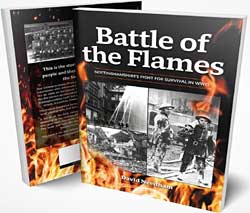Book and article reviews, Spring 2025
Battle of the Flames: Nottinghamshire’s fight for Survival in WWII by David Needham lSBN 978-1-909813-687, Bannister Publications Ltd. (Chesterfield, 2020), £17.99

‘If the Battle of Britain was won by “The Few”, the Battle of the Flames was won by the many’. This is the opening sentence to the introduction to the book that David has compiled and written.
The ‘many’ were the ordinary7 people whose everyday jobs did not involve fighting fires or saving lives, but when the time came would step up to the mark and be counted.
To these ordinary people the war was something they read about in the newspapers, or they heard of on the wireless as they listened to the BBC over the airwaves. The war was seeing loved ones enlisting and going off to fight. But, in 1940, the war suddenly became more real as it came to these shores, not from an invasion, but from the air as Hitler’s Luftwaffe carried out bombing raids on the south coast and later spreading to the industrial towns and cities across the country.
These bombing raids would bring forth the ‘many’ as they came forward to play a vital role in this nation’s history as auxiliary fire fighters, ARP wardens, ambulance drivers and first aiders, and many more roles would be filled as the war progressed by the ‘ordinary man and woman’.
Nottinghamshire air raids began in mid-August 1940 with various attacks on the city, however, it would be the air raid on the night of the 8th to 9th May 1941 that would see the city suffer its worst bombing and greatest loss of life. It would be on this night that the word ‘Blitz’ would be added to Nottingham when describing these events.
During the night some of Nottingham’s major buildings would be struck by bombs and various incendiary devices. Across the city, buildings were destroyed and burning, from the university on Shakespeare Street, to the city centre and the lace market, out to the Co-operative Bakery on Meadow Lane.
The destruction would spread across the perimeter of the city including Beeston, Sneinton, Carlton and West Bridgford. In total, during the night 424 high explosive bombs and 6,804 incendiary devices would rain from the sky.
The death toll on that night was 160 men, women and children, with hundreds treated for injuries. The greatest loss of life was at the Co-operative Bakery (50) and the Dakeyne Street public air shelter (21).
This air raid would not be the last, but none that followed would have the same devastating effect as that which took place in the early hours of 9th May 1941.
This book is the second edition of David’s original work, first published in 2009, timed to coincide with the 80th anniversary of the ‘Nottingham Blitz’. This new version explores in-depth the air raids, the destruction, the loss of life and the aftermath. The book has many new images with a large number in colour. For David, ex-Divisional Officer of Nottinghamshire Fire & Rescue Service, what started as an article for the journal of the Nottinghamshire Fire and Rescue Service in 1990 was much more, especially when he began talking to the wartime veterans of the Fire Service and the Air Raid Precautions Service. A bigger picture began to be revealed; one that needed to be told.
To quote again from David’s book: ‘This is the story of the people of Nottinghamshire and the aerial war waged against them.’ For anyone like me, whose only knowledge of these events came from stories from my parents, the book is a fascinating and revealing read and a sad and tragic reminder of these dark days in Nottinghamshire’s wartime history, a fitting tribute to the ‘many’.
Kevin Powell
Change and Continuity in Seventeenth-century Nottinghamshire P.R. Seddon (Merton Priory Press, 2025).
Hardback, 349 pages, 1 map. Price £40

Nottinghamshire played a more important part in the Civil War than any other county in the East Midlands, an aspect of its history which has long been well known. What is much less familiar is the background to the conflict in the county, its aftermath, and the impact of the Restoration of 1660. This major new book, the product of many years’ detailed research in national as well as local archives by a historian who spent almost his entire career in the History Department at the University of Nottingham, provides for the first time a detailed account of Nottinghamshire from the reign of James I to that of James II. It explores how the shire was administered by the gentry in the early seventeenth century, how taxes were levied, how the militia was raised, and how Sherwood Forest was governed under Forest Law.
This is followed by the fullest account yet published of Nottinghamshire during the Civil Wars and under the Commonwealth and Protectorate that followed, looking at how local communities were affected by the conflict and the deep social divisions it created, the varieties of religious Dissent that arose during this period, and the gradual shift in opinion in favour of the restoration of the monarchy. The final section, which continues to the Glorious Revolution of 1688, examines how the traditional administrative institutions of the county (and of Sherwood Forest) were restored after 1660, and the extent to which the rifts of the Civil War period healed (or not) during the political instability that characterised the thirty years after the return of the monarchy.
This book is not only the fullest study yet to be published of any English county in the seventeenth century but is also the largest scholarly work on any aspect of the history of Nottinghamshire to appear for a generation. Anyone with a serious interest in local history in the county will wish to acquire and read such an important book, not least for the wider background it provides to studies of individual towns and villages during this period.
The book has been published by a specialist local firm, edited, printed and bound to a very high standard. It will be a handsome addition to any collection of books on Nottinghamshire and is likely to appreciate once it goes out of print.
To order a copy simply write to Merton Priory Press Ltd, 9 Owen Falls Avenue, Chesterfield S41 OFR, enclosing a cheque for £40 (the price includes post and packing). Telephone enquiries to 01246 554026.
Philip Riden